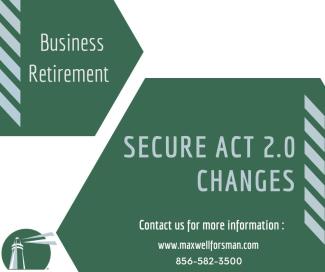
Secure Act 2.0
Secure Act 2.0
Employer Retirement Plans
REQUIRING AUTO ENROLLMENT IN NEW PLANS
• Requirement. Effective for 2025, new 401(k) and 403(b) plans would be required to include (1) automatic enrollment at a minimum of 3% and a maximum of 10% and (2) automatic escalation at one percentage point per year up to at least 10%. New plans are plans not established before the date of enactment (December 29, 2022).
• Employers excepted from requirement. Exceptions for government plans, church plans, employers with 10 or fewer employees, and new businesses that have not been in existence for three years.
• MEPs and PEPs. For purposes of the grandfather and exemptions, each employer in a Pooled Employer Plan (PEP) or Multiple Employer Plan (MEP) would be treated as maintaining a separate plan, so that, for example, a new employer joining a pre-enactment PEP or MEP would not be grandfathered.
• SIMPLEs exempted. SIMPLE plans would not be subject to this requirement.
START-UP CREDIT
Enhancement of the current start-up credit. Effective for 2023. Current law offers a tax credit to a small business (up to 100 employees) that adopts a new plan, which can apply for up to three years, equal to the lesser of (1) 50% of the employer’s start-up costs, or (2) as much as $5,000. SECURE 2.0 increases 50% to 100% for employers with 50 or fewer employees. New credit. Effective for 2023. Except in the case of defined benefit plans, an additional credit is provided equal to the applicable percentage of the amount contributed by the employer on behalf of certain employees, up to a per-employee cap of $1,000.
• This full additional credit would be limited to employers with 50 or fewer employees, and phased out for employers with between 51 and 100 employees.
• The applicable percentage would be 100% in the first and second years, 75% in the third year, 50% in the fourth year, 25% in the fifth year, and zero thereafter.
• No credit would be permitted with respect to contributions on behalf of an employee whose FICA wages for the taxable year exceed $100,000 (indexed). It is unclear whether partners and sole proprietors would be treated as employees for purposes of the credit; if so, they have no FICA wages, so the employer would receive a credit with respect to contributions on their behalf, regardless of their earned income.
Extending the start-up credit to small employers that join a MEP (which includes PEPs). SECURE 2.0 provides that small employers that join a MEP are entitled to the start-up credit for their first three years in the MEP, regardless of how long the MEP has been in existence, retroactively effective as if included in the original SECURE Act.
STARTER 401(K)
Effective for 2024, SECURE 2.0 allows an employer to adopt a starter 401(k) plan that:
- Is exempt from nondiscrimination and top-heavy testing since the contribution limit ($6,000) (indexed) is actually lower than the IRA contribution limit ($6,500 in 2023). It is unclear if it was intended to set the limit below the IRA limit.
- Must have auto enrollment, which can be set anywhere between 3% and 15%.
- Does not permit employer contributions.
- Is adopted by an employer that does not have any other plan (other than for union employees) in each year in which the starter 401(k) is in effect.
- Limits catch-up contributions to the IRA catch-up limit ($1,000) (indexed under SECURE 2.0). Starter 403(b). SECURE 2.0 also includes a parallel provision for 403(b) plans.
EMPLOYER CONTRIBUTIONS MAY BE ROTH
Employers may permit employees to elect for some or all of their vested matching and nonelective contributions to be treated as Roth contributions under a 401(k), 403(b), or governmental 457(b) plan. Effective for contributions after the date of enactment.
Emergency Savings - Roth Version
• Effective for 2024.
• Cap of $2,500 on the emergency savings account. The account can exceed $2,500 (indexed) by reason of account earnings, but no contribution can be made that would cause the account to exceed or further exceed $2,500.
• Account must be part of a defined contribution plan.
• Employee contributions are treated as Roth contributions for almost all purposes and are deemed to be qualified distributions so distributions of earnings are always nontaxable.
• Contributions must be invested in a principal preservation investment.
• Very generally amounts may be withdrawn at least once per calendar month, penalty-free.
• Auto enrollment permitted up to 3% of pay
No employer contributions permitted.
• Highly compensated employees not permitted to contribute.
• Matches required at the same rate that the plan matches elective deferrals, subject to an annual $2,500 cap. The matches would go into the retirement part of the plan, not the emergency savings part of the plan.
• Withdrawal of matched contributions. Employers shall not be required to suspend matching contributions for employees who make withdrawals of matched contributions. But under guidance to be prescribed, employers shall have unclear powers to prevent manipulation of this provision, presumably by employees who make contributions to get the match and then withdraw the contribution.
Termination of employment. On termination of employment, the plan must allow for the emergency savings account to be (1) converted to Roth in the plan if the plan allows Roth accounts and such account is not being distributed, (2) distributed to the participant, or (3) rolled over to a Roth account.
• DOL and Treasury both have authority to issue guidance on the same provisions, but they are not required to issue joint guidance. This could raise questions about the ability to rely on guidance issued by only one agency.
A Roth offers tax deferral on any earnings in the account. Qualified withdrawals of earnings from the account are tax-free. Withdrawals of earnings prior to age 59 ½ or prior to the account being opened for 5 years, whichever is later, may result in a 10% IRS penalty tax. Limitations and restrictions may apply.
Emergency Savings – Pre-Tax Version
This provision is structured very much like the qualified birth or adoption distribution (“QBAD”) provision enacted in the SECURE Act and like the special coronavirus-related distributions (“CRDs”) permitted under the CARES Act. Effective for 2024.
• Tax treatment. A distribution from a retirement plan (other than a defined benefit plan) or from an IRA that is treated as an emergency distribution is not subject to the 10% early distribution tax.
• Limits. One emergency distribution is permitted per calendar year, and that distribution cannot exceed the lesser of (a) $1,000 (not indexed) or (b) the excess of the individual’s vested benefit over $1,000 (not indexed).
• Plan treatment. A 401(k), 403(b), or governmental 457(b) plan may allow – but is not required to allow – emergency distributions to individuals who otherwise would not qualify for a distribution.
Self-certification. A plan may rely on a participant’s certification that the distribution requested is an emergency distribution.
• Ability to recontribute. An individual who takes an emergency distribution has the right to roll the distribution back into the same plan or to an IRA within three years and thus render the original distribution non-taxable (which may require an amended return).
• New rule (compared to QBADs): requirement to replenish retirement savings before taking an additional emergency distribution from the same plan or IRA. If an individual takes an emergency distribution from a plan or IRA, such individual is not permitted to take another emergency distribution within the next three calendar years from the same plan or IRA unless the individual (1) has rolled the distribution back to the same plan or IRA or (2) has subsequently made contributions to the same plan or IRA in an amount at least equal to the amount of the prior emergency distribution.
CATCH-UP CONTRIBUTIONS -- ROTH
Requirement that catch-up contributions other than under SIMPLE plans must be made on a Roth basis. Effective for 2024.
• $145,000 rule. The requirement that catch-up contributions be made on a Roth basis only applies to employees whose wages (as defined for Social Security FICA tax purposes) were over $145,000 (indexed) in the prior year. Technically, this means that self-employed individuals (partners and sole proprietors) are not subject to the Roth catch-up requirement. That seems like a glitch that will be addressed at some point.
• Plans generally required to offer Roth catch-up contributions. If any participant in a plan to which the Roth catch-up rule applies has wages over $145,000 in the prior year, then no participant may make catch-up contributions unless the plan allows Roth catch-up contributions.
• Allowing participants to change elections. Assume that a participant is determined to be ineligible to make pre-tax Roth contributions by reason of having wages in excess of $145,000. Treasury is permitted to issue regulations permitting such a participant to change her election to make catch-up contributions if the election was made before the wage determination was made.
• New rule not applicable to special 457(b) and 403(b) catch-up contributions.
HIGHER CATCH-UP CONTRIBUTIONS
Higher catch-up contribution for individuals who are ages 60-63. Effective for 2025. The limit on catch-up contributions for 2023 is $7,500, except in the case of SIMPLE plans for which the limit is $3,500. SECURE 2.0 increases these limits for employees who are 60-63.
• The $7,500 limit is increased to the greater of (1) $10,000 (indexed) or (2) 150% of the regular catch-up (which would be $11,250 in 2023).
• The $3,500 limit is increased to the greater of (1) $5,000 or (2) 150% of the regular SIMPLE catchup (which would be $5,250 in 2023).
SEP AND SIMPLE ROTH CONTRIBUTIONS
Allowing SIMPLE and SEP contributions to be made on a Roth basis. Effective for taxable years beginning after 2022. Unlike 401(k), 403(b), and governmental 457(b) plans, SIMPLEs and SEPs are not permitted to offer a Roth option; instead, all contributions must be pre-tax. SECURE 2.0 allows employers to permit employees to elect Roth treatment of both employer and employee contributions.
SIMPLE PLAN LIMITS
SIMPLE contribution limit. SECURE 2.0 includes the following provisions, effective for 2024:
• Higher limit for employers with up to 25 employees. For employers with up to 25 employees, the SIMPLE plan limit on employee contributions is increased from $15,500 (2023) to 110% of whatever that figure is for 2024 (and then indexed), and the catch-up limit is increased from $3,500 (2023) to 110% of whatever that figure is for 2024 (and then indexed). There is a two-year grace period during which an employer that fit within this rule but then grows beyond 25 employees would continue to be treated as having 25 employees.
• Other small employers: higher limit conditioned on additional employer-provided benefits. Employers with more than 25 employees but not more than 100 could elect to apply the same increases described above, but only if the employer also agrees to make matching contributions up to 4% (instead of 3%) or nonelective contributions up to 3% (instead of 2%). (For non-electing employers, the current-law SIMPLE IRA rules would continue to apply, so no existing SIMPLE IRA would need to be changed and new ones could be sold the same way.)
• Increases only applicable if no plan within three years. The above limit increases only apply to employers that have not maintained a 401(k) plan or 403(b) plan for three years; the objective is to prevent employers from dropping their 401(k) or 403(b) plan and moving to a SIMPLE plan.
SIMPLE NONELECTIVE CONTRIBUTIONS
Additional nonelective contributions permitted to SIMPLE plans. Effective for 2024. Under current law, an employer sponsoring a SIMPLE plan can make matching contributions up to 3% of pay or nonelective contributions of 2% of pay, but no other employer contributions are permitted. Under SECURE 2.0, an employer would be permitted to make up to an additional 10% nonelective contribution on behalf of all eligible employees, not to exceed $5,000 (indexed).
LONG-TERM PART-TIME EMPLOYEES
Long-term part-time workers: three years to two years. Effective for 2025, except as noted.
• Background. Prior to the SECURE Act, employers generally could exclude certain part-time employees (i.e., employees who have not satisfied a requirement that they have 1,000 hours of service in a year) when providing a plan to their employees. SECURE generally required 401(k) plans (other than collectively bargained plans) to have a dual eligibility requirement under which an employee must complete either a one year of service requirement (with the 1,000-hour rule) or three consecutive years of service where the employee completes at least 500 hours of service.
• Three years to two years. SECURE 2.0 reduces the three-consecutive-years requirement to two years
• Expansion of rule to ERISA and ERISA 403(b) plans. SECURE 2.0 includes the two-consecutive years rule not only in the Code, but also in ERISA, and broadens it to apply to ERISA-covered 403(b) plans in addition to 401(k) plans. The inclusion in ERISA would make the eligibility rule for part-time employees an enforceable right, as opposed to only a tax qualification requirement (as under current law).
• Service. For purposes of ERISA, service prior to 2023 would be disregarded for vesting and eligibility purposes. SECURE 2.0 also provides that pre-2021 service is disregarded for vesting purposes under the Code, just as such service is disregarded for eligibility purposes under current law; this change is retroactive as if included in the original SECURE Act.

